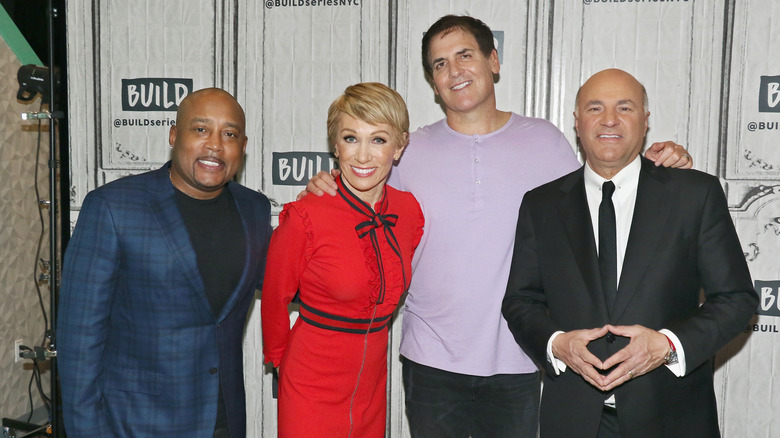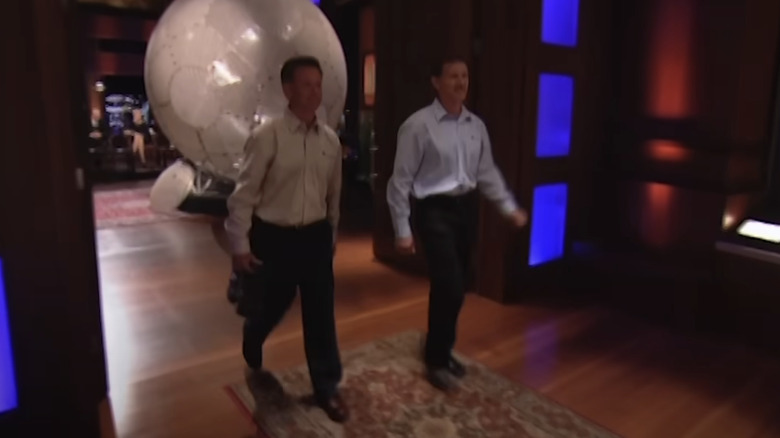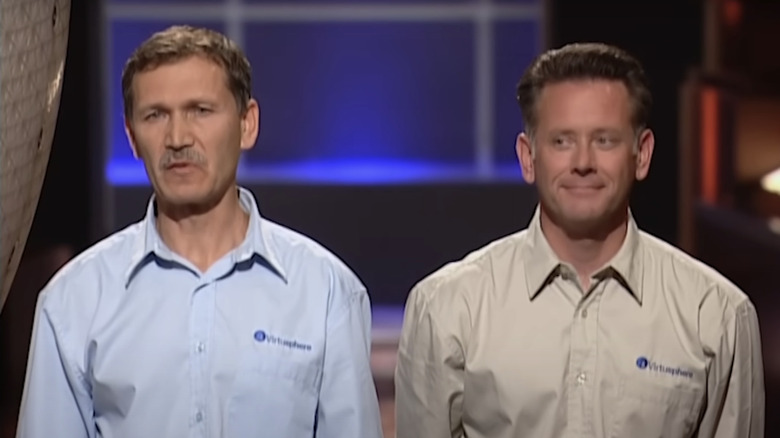What Happened To Virtusphere From Shark Tank Season 1?
In 2009, when "Shark Tank" was still in its infancy, virtual reality wasn't as mainstream and as big of a deal as it is after the likes of Meta, Valve, Sony, Google, and Apple started producing VR headsets. More than a decade later, the VR space has transformed into a multi-billion industry. Worldwide, market data suggests VR could grow to nearly half a trillion by 2030. Hence, it's not surprising that many startups are banking on VR to achieve success in the field of technology business. Some have taken their chances on ABC's hit investment-centric series, such as the Virtuix Omni VR motion gaming system and the Da Vinci Eye AR art projector. However, none of them have been as ambitious as Virtusphere, a company selling a full-body VR experience in a 10-foot sphere.
When co-founders Ray Latypov and Jim DiMascio pitched the product in Season 1, Episode 9, they relied on its novelty and possible applications in both gaming and high-risk training environments to sell it to the sharks. At first glance, the VR simulator looked very enticing despite its intimidating size. They said the spherical enclosure was designed to enhance the VR experience through its 100-square-foot interior space, providing enough room for when the entire thing rotates depending on the movement of the user inside. The idea was nothing short of commendable, but something did not sit well with the sharks.
What happened to Virtusphere on Shark Tank?
Ray Latypov and Jim DiMascio entered the tank in season 1, seeking $1.5 million in investment in exchange for 10% equity. Right off the bat, this raised the expectations of the sharks, who passed on the Ionic Ear Bluetooth implant and the Lifebelt car safety feature in the same season. Latypov's discussion of the Virtusphere's technology further piqued the interest of some of them. In particular, Kevin O'Leary was so interested that he agreed to test its VR experience. After the demo, he admitted that it was disorienting and might take some time to get used to. Virtusphere allows users inside to walk, run, or even crawl while engaging in a VR environment via the wireless head-mounted display. According to Latypov, their product could change the way the military trains its soldiers.
However, as their pitch continued, the sharks realized that Virtusphere was still in its nascent stage. They also uncovered how selling it to commercial consumers would be an uphill battle. For one, each unit cost $14,000 to make, and the startup was selling them for $35,000 each. It did not help that Kevin Harrington brought up potential liability issues. O'Leary was the first to drop out, saying the business was unlikely to be profitable. Harrington, Barbara Corcoran, and Daymond John tapped out for different reasons. Robert Herjavec, who was so intrigued by the simulator, also did not offer a deal since he wasn't sure who would be willing to buy it.
Virtusphere fails to secure a deal but it remains operational
After failing to land a deal with any of the sharks, Latypov and DiMascio walked away from the tank empty-handed. However, this did not stop them from pursuing the big dream. They continued to market Virtusphere as a VR device for entertainment, education, and military training and found success in select niches. They attended different conventions, such as Google IO, CES, and GameON, and sold units to various entities, including the Orlando Science Center, Museum of Telecommunications in Russia, StarVR in China, and SkyVR Park in Malaysia. They also sold their VR simulator to different schools, such as Harrisburg University, HSLU in Switzerland, and Bremen University in Germany. According to Shark Tank Recap, the U.S. Army medical center is also one of its clients, along with a naval research base.
Virtusphere also tried to expand its product lineup. In August 2013, it launched a Kickstarter campaign for a virtual reality headset called 360specs. The goal was to raise $100,000 for product development. However, the campaign proved to be unsuccessful, raising only less than 4% of the target. It's not clear if the firm fully scrapped the product or put it on the back burner. As for its main business, Virtusphere's annual revenue reached $3 million as of July 2021. Despite this, it hasn't done any fundraising (at least not that's publicly documented). Hence, it's hard to determine its exact net worth in 2025. However, the fact that the company is still fully operational is already a feat on its own.
What's next for the Virtusphere co-founders?
Ray Latypov is still with Virtusphere, and he remains the company's CEO, as per his LinkedIn profile. Ray and his brother, Allan Latypov, were the brains behind the hamster ball-inspired simulator. Ray considers himself an inventor and a scientist, so he continues to develop new concepts in line with virtual reality and mobile technologies. He also currently serves as the Chief Technology Officer of Virtual Sphere Limited. Other than this, not much is known about his present whereabouts, since he appears to be inactive on social media. His Facebook account is empty, while his LinkedIn only lists his working experiences.
Meanwhile, Jim DiMascio is no longer part of Virtusphere. In fact, it has been many years since he left his COO position at the VR-focused company. According to his LinkedIn profile, he only worked there for around 2 years before quietly exiting in March 2010. He quickly moved on to work for the wholesale lighting, telecom, and electrical company Friedman Electric. He spent 6 years working as their New York branch manager. DiMascio then served as the business development manager of City Electric Company Inc. in the Greater Syracuse-Auburn area between January 2016 and April 2018. As of late, he works as the business development and safety manager at Cooper Electric in Johnson City, New York. Unlike Latypov, DiMascio has a more visible social media presence, as he likes to share family photos on Facebook.



